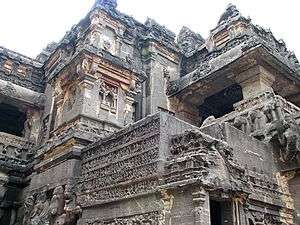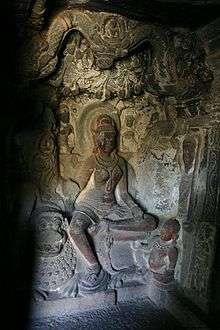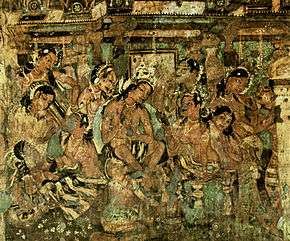Ellora Caves
| Ellora caves वेरुळ लेणी/ಎಲ್ಲೋರ ಗುಹೆಗಳು | |
|---|---|
| Name as inscribed on the World Heritage List | |
|
Kailasanatha Temple, (Cave 16) view from the top of the rock | |
| Type | Cultural |
| Criteria | (i) (iii) (vi) |
| Reference | 243 |
| UNESCO region | South Asia |
| Inscription history | |
| Inscription | 1983 (Unknown Session) |
 Location of Ellora Caves in India Maharashtra. | |
Ellora (\e-ˈlȯr-ə\, Vērūḷ) is an archaeological site 29 km (18 mi) north-west of the city of Aurangabad in the Indian state of Maharashtra, built by the Rashtrakuta dynasty(Brahmanical & Buddhist group of caves ) and Yadav (Jain group of caves). It is also known as Elapura in the Rashtrakuta Kannada literature. Well known for its monumental caves, Ellora is an UNESCO World Heritage Site and forms one of major tourist attraction in Marathwada region of Maharashtra[1] Ellora represents the epitome of Indian rock-cut architecture.[2] The 34 "caves" are actually structures excavated out of the vertical face of the Charanandri hills. Hindu, Buddhist and Jain rock-cut temples and viharas and mathas were built between the 5th century and 10th century. The 17 Hindu (caves 13–29), 12 Buddhist (caves 1–12) and 5 Jain (caves 30–34) caves, built in proximity, demonstrate the religious harmony prevalent during this period of Indian history.[3] It is a protected monument under the Archaeological Survey of India.[4]
Etymology
Ellora, also called Verul or Elura, is the cave form of the Ancient name Elapura.[5]
History
Ellora is known for Hindu, Buddhist and Jain cave temples built during (6th and 9th centuries) the rule of the Kalachuri, Chalukya and Rashtrakuta dynasties. The Jagannatha Sabha a group of five Jain cave temples of 9th century built by Rashtrakuta.[6] Verul Ellora is around 28 km from Aurangabad, 450 km from Nagpur, 400 km from Mumbai, 150 km from Jalgaon & 200 km from Buldhana.
The Hindu caves
The Hindu caves were constructed between the middle of sixth century to the end of the eighth century. The early caves (caves 17–29) were constructed during the Kalachuri period. The work first commenced in Caves 28, 27 and 19. These were followed by two most impressive caves constructed in the early phase - Caves 29 and 21. Along with these two, work was underway at Caves 20 and 26, and slightly later at Caves 17, 19 and 28.[7] The caves 14, 15 and 16 were constructed during the Rashtrakuta period. The work began in Caves 14 and 15 and culminated in Cave 16.[7] All these structures represent a different style of creative vision and execution skills. Some were of such complexity that they required several generations of planning and co-ordination to complete.
The Kailasanatha temple
|
|
|
Cave 16, also known as the Kailasa temple, is the unrivaled centerpiece of Ellora. This is designed to recall Mount Kailash, the abode of Lord Shiva – looks like a freestanding, multi-storeyed temple complex, but it was carved out of one single rock, and covers an area double the size of Parthenon in Athens.[8] Initially the temple was covered with white plaster thus even more increasing the similarity to snow-covered Mount Kailash.
All the carvings are done in more than one level. A two-storeyed gateway resembling a South Indian Gopura opens to reveal a U-shaped courtyard. The courtyard is edged by columned galleries three storeys high. The galleries are punctuated by huge sculpted panels, and alcoves containing enormous sculptures of a variety of deities. Originally flying bridges of stone connected these galleries to central temple structures, but these have fallen.
Within the courtyard are three structures. As is traditional in Shiva temples, the first is a large image of the sacred bull Nandi in front of the central temple. The central temple - Nandi Mantapa or Mandapa - houses the Lingam. The Nandi Mandapa stands on 16 pillars and is 29.3 m high. The base of the Nandi Mandapa has been carved to suggest that life-sized elephants are holding the structure aloft. A living rock bridge connects the Nandi Mandapa to the Shiva temple behind it. The temple itself is a tall pyramidal structure reminiscent of a South Indian Dravidian temple. The shrine – complete with pillars, windows, inner and outer rooms, gathering halls, and an enormous lingam at its heart – carved from living stone, is carved with niches, pilasters, windows as well as images of deities, mithunas (erotic male and female figures) and other figures. Most of the deities at the left of the entrance are Shaivaite (followers of Shiva) while on the right hand side the deities are Vaishnavaites (followers of Vishnu). There are two Dhvajastambhas (pillars with the flagstaff) in the courtyard. The grand sculpture of Ravana attempting to lift Mount Kailasa, the abode of Lord Shiva, with his full might is a landmark in Indian art. The construction of this cave was a feat of human genius – it entailed the removal of 200,000 tonnes of rock, and took 100 years to complete.
The temple is a splendid achievement of Rashtrakuta Karnataka architecture. This project was started by Krishna I (757–773) of the Rashtrakuta dynasty that ruled from Manyakheta in present day Karnataka state. His rule had also spread to southern India, hence this temple was excavated in the prevailing style. Its builders modelled it on the lines of the Virupaksha Temple in Pattadakal. Being a south Indian style temple, it does not have a shikhara common to north Indian temples. – The Guide to the Architecture of the Indian Subcontinent, 1996, Takeo Kamiya, Japan Architects Academy and archaeological Survey of India
The Dashavatara
The Dashavatara (Cave 15) was begun as a Buddhist monastery. It has an open court with a free-standing monolithic mandapa at the middle and a two-storeyed excavated temple at the rear. The layout of the temple is closely related to caves 11 and 12. Large sculptural panels between the wall columns on the upper floor illustrate a wide range of themes, which include the ten avatars of Vishnu. An inscription of grant of Dantidurga is found on the back wall of the front mandapa. According to Coomaraswamy, the finest relief of this cave is the one depicting the death of Hiranyakashipu, where Vishnu in man-lion (Narasimha) form, emerges from a pillar to lay a fatal hand upon the shoulder of Hiranyakashipu.[9]
Other Hindu caves

Other notable Hindu caves are the Rameshvara (Cave 21), which has figurines of river goddesses Ganga and Yamuna at the entrance and the Dhumar Lena (Cave 29) whose design is similar to the cave temple on Elephanta Island near Mumbai. Two other caves, the Ravan ki Khai (Cave 14) and the Nilkantha (Cave 22) also have several sculptures. The rest of the Hindu caves, which include the Kumbharvada (Cave 25) and the Gopilena (Cave 27) have no significant sculptures.
The Jain caves

The five Jain caves at Ellora belong to the ninth and tenth centuries. They all belong to the Digambara sect.[10] Jain caves reveal specific dimensions of Jain philosophy and tradition. They reflect a strict sense of asceticism – they are not relatively large as compared to others, but they present exceptionally detailed art works. The most remarkable Jain shrines are the Chhota Kailash (cave 30), the Indra Sabha (cave 32) and the Jagannath Sabha (cave 33). Cave 31 is an unfinished four-pillared hall and a shrine.[11] Cave 34 is a small cave, which can be approached through an opening on the left side of Cave 33.[12] Amongst other devotional carvings, a place called Samavasarana can be found in Elora caves. Samavasarana is of special interest to Jains, as it is a hall where the tirthankara preaches after attaining omniscience.[13]
The Indra Sabha
The Indra Sabha (Cave 32) is a two storeyed cave with one more monolithic shrine in its court. It has a very fine carving of the lotus flower on the ceiling. It got the appellation "Indra Sabha" probably it is significantly ornate and also because of the sculpture of the yaksha (dedicated attendant deity) Matanga on an elephant, which was wrongly identified as that of Indra. On the upper level of the double-storied shrine excavated at the rear of the court, an U image of Ambika, the yakshini of Neminath, is found seated on her lion under a mango tree, laden with fruits.
Other Jain caves
All other Jain caves are also characterized by intricate detailing. Many of the structures had rich paintings in the ceilings – fragments of which are still visible.
The Buddhist caves




These caves were built during the 5th-7th century. It was initially thought that the Buddhist caves were one of the earliest structures, created between the fifth and eighth centuries, with caves 1-5 in the first phase (400-600) and 6-12 in the later phase (mid 7th-mid 8th), but now it is clear to the modern scholars that some of the Hindu caves (27,29,21,28,19,26,20,17 and 14) precede these caves. The earliest Buddhist cave is Cave 6, followed by 5,2,3,5 (right wing), 4,7,8,10 and 9. Caves 11 and 12 were the last. All the Buddhist caves were constructed between 630-700.[14]
These structures consist mostly of viharas or monasteries: large, multi-storeyed buildings carved into the mountain face, including living quarters, sleeping quarters, kitchens, and other rooms. Some of these monastery caves have shrines including carvings of Gautama Buddha, bodhisattvas and saints. In many of these caves, sculptors have endeavoured to give the stone the look of wood.[15]
Most famous of the Buddhist caves is cave 10,(refer map) a chaitya hall (chandrashala) or 'Vishvakarma cave', popularly known as the 'Carpenter's Cave'. Beyond its multi-storeyed entry is a cathedral-like stupa hall also known as chaitya, whose ceiling has been carved to give the impression of wooden beams. At the heart of this cave is a 15-foot statue of Buddha seated in a preaching pose. Amongst other Buddhist caves, all of the first nine (caves 1–9) are monasteries. The last two caves, Do Tal (cave 11) and Tin Tal (cave 12) have three stories.
Cave 10
Cave 10 is a vihara with eight cells, four in the back wall and four in the right wall. It had a portico in the front with a cell.[14] Possibly served as a granary for other viharas.
The Vishwakarma

The Vishwakarma (Cave 10) is the only chaitya griha amongst the Buddhist group of caves. It is locally known as Vishwakarma "celestial architect" or Sutar ka jhopda "carpenter's hut". It follows the pattern of construction of Caves 19 and 26 of Ajanta. On stylistic grounds, the date of construction of this cave is assigned to 700 A.D. The chaitya once had a high screen wall, which is ruined at present. At the front is a rock-cut court, which is entered through a flight of steps. Upstairs, on either side are pillared porticos with chambers in their back walls. These were probably intended to have subsidiary shrines but not completed. The pillared verandah of the chaitya has a small shrine at either end and a single cell in the far end of the back wall. The corridor columns have massive squarish shafts and ghata-pallava (vase and foliage) capitals. The main hall is apsidal on plan and is divided into a central nave and side aisles by 28 octagonal columns with plain bracket capitals. In the apsidal end of the chaitya hall is a stupa on the face of which a colossal 3.30 m high seated Buddha in vyakhyana mudra (teaching posture) is carved. A large Bodhi tree is carved at the back. The hall has a vaulted roof in which ribs (known as triforium) have been carved in the rock imitating the wooden ones.[16] The friezes above the pillars are Naga queens, symbolic of the monsoon, as well as dwarfs as entertainers, dancing and playing musical instruments.[17]
Geology of Ellora
Ellora occupies a relatively flat region of the Western Ghats. Ancient volcanic activity in this area created many layered basalt formations, known as Deccan Traps. During the Cretaceous, one such volcanic hill formed on the southwest-facing side of Ellora. Its vertical face made access to many layers of rock formations easier, enabling architects to pick basalt with finer grains for more detailed sculpting.[18]
Inscriptions at Ellora
Several inscriptions at Ellora[19] range from 6th century to 15th century. The best known of them is an inscription of Rashtrakuta Dantidurga (c. 753-57 A.D.) on the back wall of the front mandapa of Cave 15, which gives an account of his conquests. Inscriptions on the Kailash temple itself range from 9th to 15th century. Jain cave Jagannatha Sabha has 3 inscriptions that give the names of monks and donors. A Parshvanth temple on the hill [20] has an 11th-century inscription that gives the name of the donor from Vardhanapura.
The Great Kailasa (Cave 16) is attributed to Krishna I (c. 757-83 A.D.), the successor and uncle of Dantidurga. A copper plate grant by Karka II (c. 812-13 A.D.) narrates that a great edifice was built on a hill by Krishnaraja at Elapura (Ellora).
The Ellora caves, unlike Ajanta, were never lost. There have been several written records that indicate that these caves were visited regularly. The earliest is that of the Arab geographer Al-Mas‘udi of the 10th century A.D. In 1352 A.D. Sultan Hasan Gangu Bahmani, who camped at the site and visited the caves. The others are by Firishta, Thevenot (1633–67), Niccolao Manucci (1653-1708), Charles Warre Malet (1794), and Seely (1824)[21]
See also
- Tourism in Marathwada
- Ajanta Caves
- Badami Cave Temples
- Barabar Caves
- Elephanta Caves
- Indian rock-cut architecture
- List Of Colossal Sculpture In Situ
- List of rock cut temples in India
- Tourism in India
- Udayagiri Caves
References
- ↑ "Ellora Caves - UNESCO World Heritage Centre". Whc.unesco.org. 2008-03-06. Retrieved 2010-08-12.
- ↑ Gopal, Madan (1990). K.S. Gautam, ed. India through the ages. Publication Division, Ministry of Information and Broadcasting, Government of India. p. 178.
- ↑ Time Life Lost Civilizations series: Ancient India: Land Of Mystery (1994)
- ↑ "Ellora Caves". Retrieved 2012-05-19.
- ↑ World Heritage Series ELLORA, Archaeological Survey of India, Government of India, Page 6. ISBN 81-87780-43-6. Printed by GoodEarth Publications, Eicher GoodEarth Limited @ Thomson Press, New Delhi
- ↑ "[Close view of base of pillars in the upper floor of the Jain Cave XXXIII (Jaganatha Sabha), Ellora.]". Retrieved 2013-09-02.
- 1 2 Dhavalikar 2003, p. 33
- ↑ Sarina Singh ... (2007). India. Footscray, Vic.: Lonely Planet. p. 810. ISBN 978-1-74104-308-2.
- ↑ Coomaraswamy, Ananda K. (1999). Introduction to Indian Art, New Delhi: Munshiram Manoharlal, ISBN 81-215-0389-2, p.5
- ↑ Dhavalikar 2003, p. 87
- ↑ Dhavalikar 2003, p. 88
- ↑ Dhavalikar 2003, p. 96
- ↑ Owen 2012, p. 15
- 1 2 Dhavalikar 2003, p. 12
- ↑ "Ellora Caves, India". Maharashtra, India: Sacred-destinations.com. 2009-08-08. Retrieved 2010-08-12.
- ↑ Dhavalikar 2003, pp. 20–3
- ↑ http://www.remotetraveler.com/ellora-caves/
- ↑ "Geology of Ellora". ellora.ind.in.
- ↑ Monolithic Jinas The Iconography Of The Jain Temples Of Ellora, p.87, Appendix I THE INSCRIPTIONS AT ELLORA, José Pereira, Motilal Banarsidass Publ., Jan 1, 1977
- ↑ Bharat ke Digambar Jain Tirth Part 4, Balbhadra Jain
- ↑ World Heritage Sites - Ellora Caves, Archaeological Survey of India http://asi.nic.in/asi_monu_whs_ellora.asp
Further reading
- Dhavalikar, M.K. (2003). Ellora. Oxford University Press, New Delhi. ISBN 0-19-565458-7.
- Berkson, Carmel (1992). Ellora, Concept and Style. Abhinav Publications. ISBN 0-19-565458-7.
- Owen, Lisa (2012), Carving Devotion in the Jain Caves at Ellora, BRILL, ISBN 978-90-04-20629-8
External links
| Wikimedia Commons has media related to Ellora Caves. |
| Wikisource has the text of the 1911 Encyclopædia Britannica article Ellora. |
- Ellora Caves Tourist Guide
- Article on Ellora
- Ellora Art Architecture Archcelogy History Culture Study
- ELLORA.ind.in
- Video of the caves MTDC site
- Ellora Caves in UNESCO List
- Ellora Art Architecture Heritage and Culture Exhibition
- Ellora Caves, Kailasanatha Temple by Wondermondo
- Photographs of Ellora
| ||||||||||||||||||||
| ||||||||||||||||||||||||||||||||||||||||
| ||||||||||||||||||||||||||||||||||||||||||||||||||||||||||||
| ||||||
Coordinates: 20°01′35″N 75°10′45″E / 20.02639°N 75.17917°E
|










